Bionic Eyes Market Size
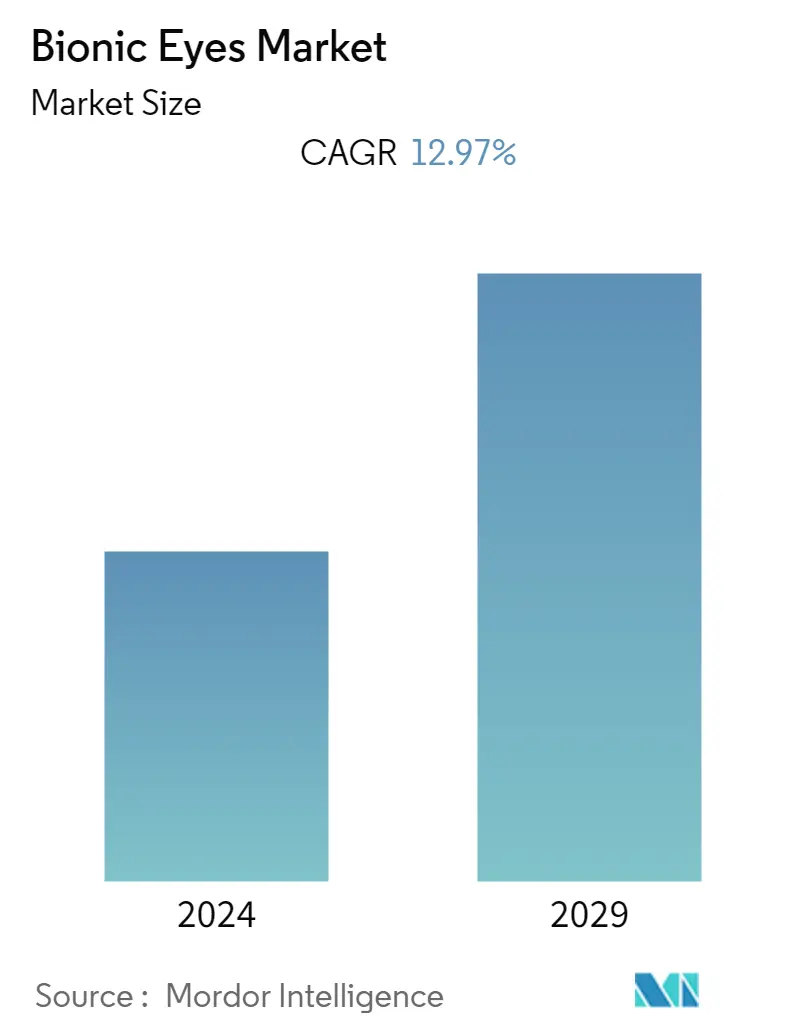
| Study Period | 2019 - 2029 |
| Base Year For Estimation | 2023 |
| CAGR | 12.97 % |
| Fastest Growing Market | Asia Pacific |
| Largest Market | North America |
| Market Concentration | Medium |
Major Players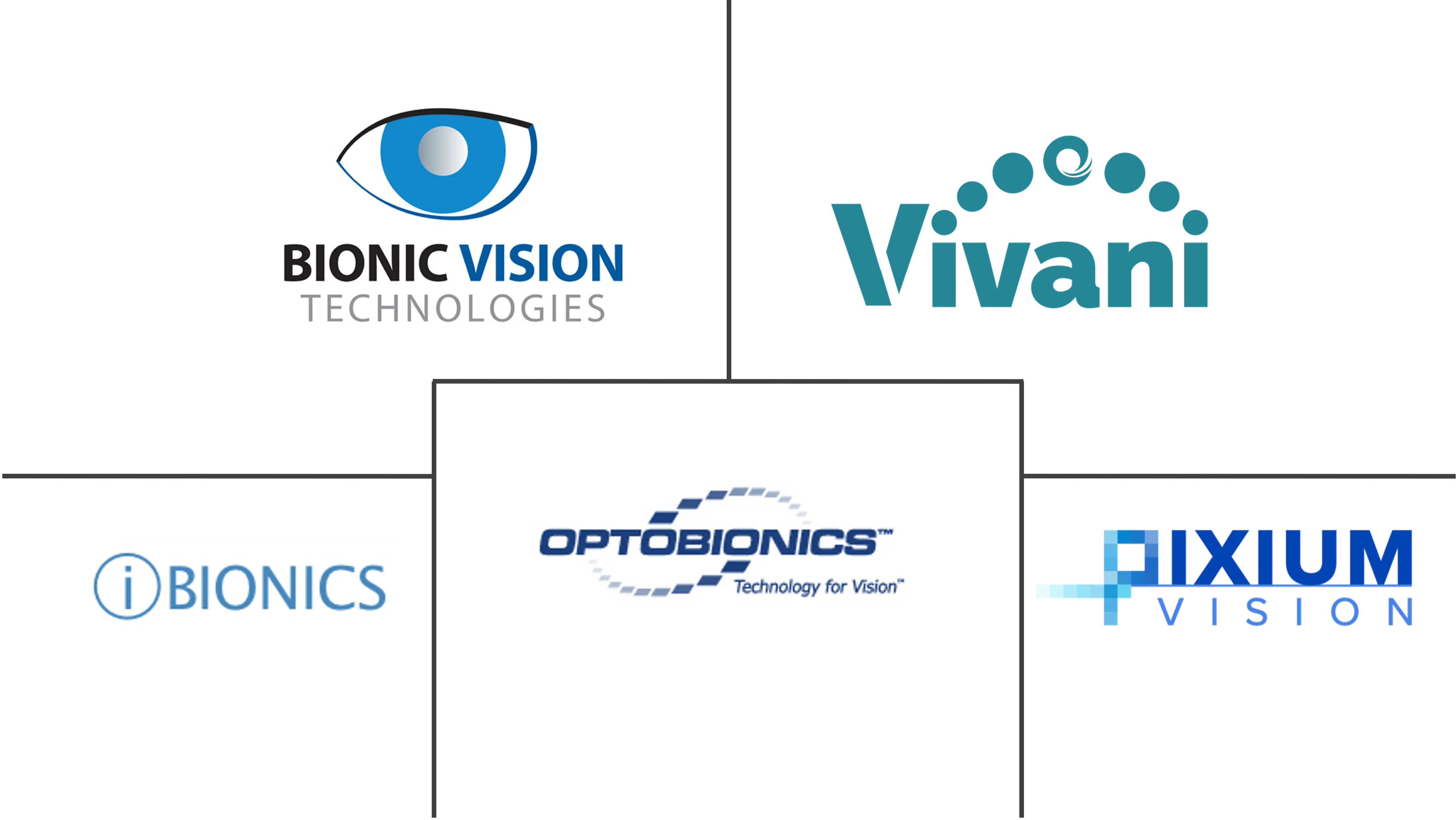
*Disclaimer: Major Players sorted in no particular order |
Bionic Eyes Market Analysis
The bionic eyes market is expected to register a CAGR of 12.97% during the forecast period.
The onset of the COVID-19 pandemic had a significant impact on the market studied. During the initial phases of the pandemic, the healthcare system was disrupted, and most of the non-essential treatments were halted. As patients requiring bionic implants were at higher risk of getting infected by COVID-19 during the procedures, following close contact with healthcare professionals, these implant procedures were postponed. This adversely impacted the studied market during the initial phases of the pandemic.
However, the rising burden of issues related to retina and vision loss among chronic COVID-19 infected patients increased the demand for retinal implants, creating opportunities for the market's growth. As per a research study published in the Vision Journal (MDPI) in September 2022, patients with SARS-CoV-2 infection experienced vision loss and impaired visual acuity as an atypical symptom, which needed prompt assessment among the target patients. Hence, such a burden of eye diseases among patients during the pandemic created new opportunities for adopting bionic eyes, driving the market's growth over the analysis period.
Factors such as the growing prevalence of vision loss and other chronic eye diseases, increasing funding by private and public organizations, and rapid advancements in technological developments are expected to fuel the market growth during the analysis period.
The bionic eye implants are still in its infancy, but due to the increasing interest of researchers in the development of innovative products and bringing it to the market for patient care is one of the major factors that drive the growth of the market. For instance, in December 2021, the Phoenix99 bionic eye developed by a team of researchers at the University of Sydney and UNSW was demonstrated to be safe and stable for long-term implantation, and the researchers applied for ethics approval for human trials of the device. The goal of the implantable device was to give people who have severe blindness or vision impairment due to degenerative diseases like retinitis pigmentosa a chance to regain their vision. Hence, the advancements in research and development are predicted to create numerous opportunities for market growth, contributing to the overall market growth during the forecast period.
Furthermore, vision loss and vision impairment has become a major cause of concern across the globe, which creates demand for bionic eyes. For instance, as per data updated by WHO in October 2022, vision impairment and blindness pose a higher financial burden and productivity losses, which are majorly caused by uncorrected refractive errors and cataracts. In addition, vision impairment and blindness can affect people of any age, but it mostly affects people of age 50 years and older. Hence, it is expected to drive the overall market growth in the coming years.
However, the high cost of bionic eyes and lack of awareness among the target population regarding these advanced implants are anticipated to hinder the overall market growth.
Bionic Eyes Market Trends
Implanted Eye Segment is Predicted to Grow Significantly Over the Forecast Period
The implanted eye segment is growing due to increasing research and development and is expected to witness considerable growth during the analysis period. Research is going on for the innovation and development of implanted eyes, and researchers are intended to develop novel ways to bring vision restoration to patient care, and bionic eye implants are one such innovation. Thus, owing to increasing research and associated benefits, the segment is anticipated to grow during the forecast period.
Implanted bionic eyes replace natural eyes using various types of technology, depending on the specific eye or prototype. Argus II Retinal Prosthesis System is commercially available in the United States and is the world's first FDA-approved prosthetic retina implant. This stimulates the inner retina with electrical signals from a camera and a computer which further provides the vision to patients with severe vision loss from retinal degeneration. It is the first and only commercially approved implant in Europe, the United States, and others. It has an epiretinal microelectrode array that is surgically implanted on the retinal surface and restores the vision of the patient. Such innovative products in the segment are anticipated to fuel the segment's growth during the analysis period.
Furthermore, growing funding activities in the segment are expected to drive the segment's growth over the analysis period. For instance, in October 2022, Biomedical researcher Michael Beyeler, an assistant professor of computer science and psychological and brain sciences at UC Santa Barbara, received USD 1.5 million as NIH Director's New Innovator award to enable a smart bionic eye and investigate the difficulties faced by implanted bionic eyes, which convert the light collected by a head-mounted camera into electrical pulses and send them through a microelectrode array implanted in the eye or the visual cortex. Such investments are anticipated to fuel the mart's growth over the analysis period.
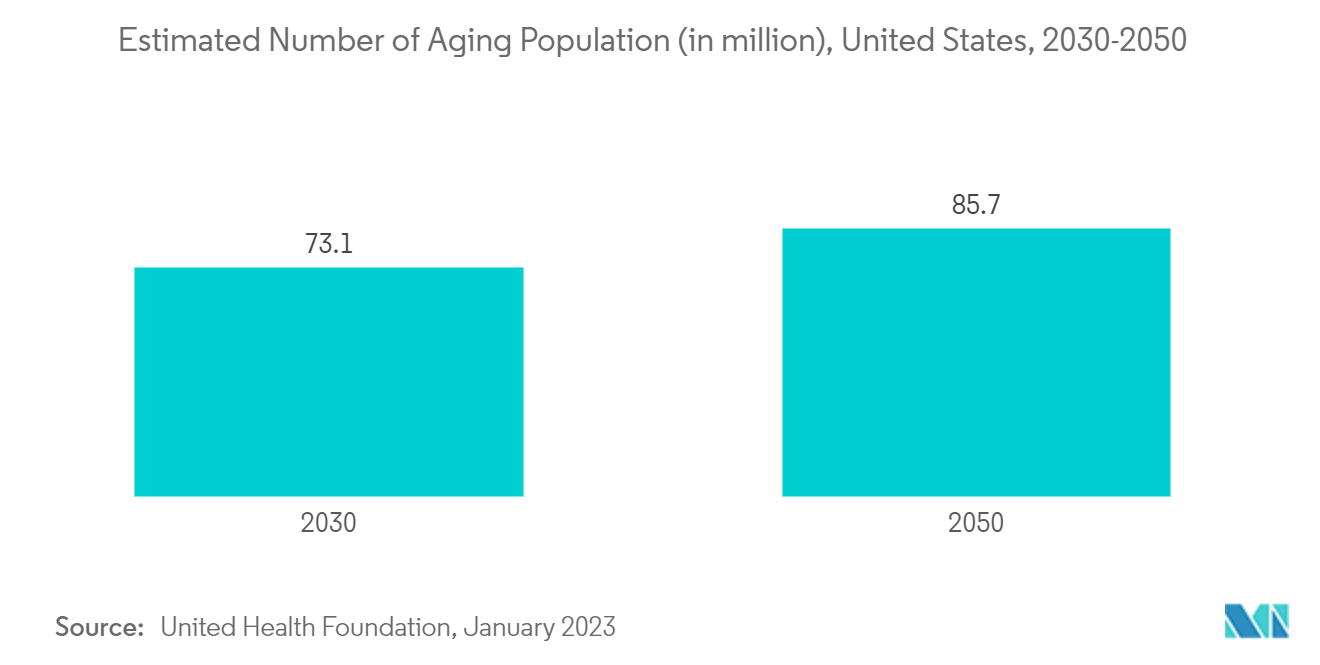
North America is Anticipated to Hold a Significant Share of the Studied Market
North America is expected to hold a major market share, owing to the high prevalence of various chronic diseases such as cancer among women, rising incidence of lifestyle-related disorders, high adoption of technologically advanced products, product launches, and government initiatives.
The aging population most commonly gets affected by vision loss and dry age-related macular degeneration (dry AMD), which increases the adoption of bionic eye use among older people, which helps in vision restoration. Hence, with the increasing older population in the country, the demand for photochromic lenses is increasing.
For instance, according to the data updated by the United Health Foundation in January 2023, the total number of adults ages 65 and older is projected to rise to an estimated 73.1 million by 2030 and 85.7 million by 2050 in the United States. As the number of older people is projected to reach, the demand for bionic eye implants is predicted to increase in the country, further creating opportunities for the market growth of the bionic eye in the United States.
Furthermore, diabetic retinopathy (DR) is one of the major causes of concern among people with diabetes, which most often causes sudden vision loss. Hence, with rising concerns about DR in the United States, the associated vision loss is increasing and is expected to drive the demand for bionic eyes. For instance, according to data released by Jobson Healthcare Information LLC in June 2022, diabetes is one of the major causes of blindness in working-age adults, and nearly 11.7% of adults in the United States with diabetes had vision disability, including blindness in recent years and approximately half of the patients with diabetes are estimated to have DR by 2030 increasing the burden of blindness. Thus, the high-risk population in the country is expected to increase the demand for bionic eyes and fuel the market's growth over the analysis period.
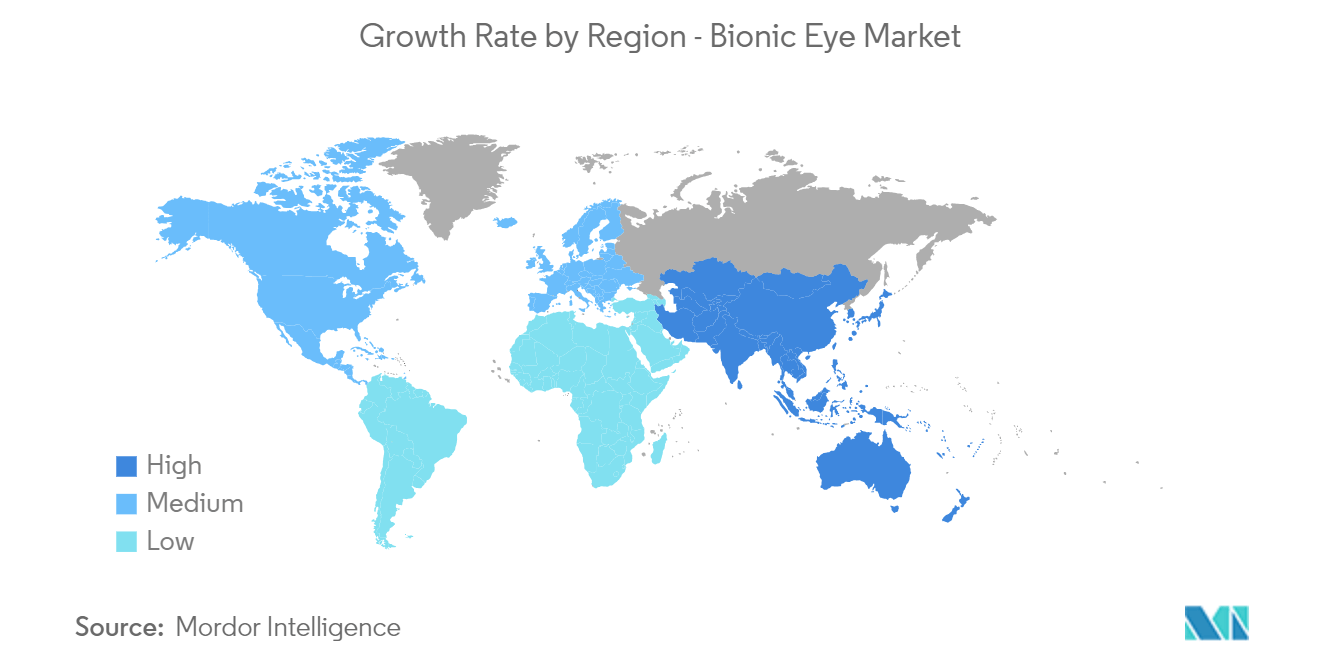
Bionic Eyes Industry Overview
The market for bionic eyes is moderately competitive and consists of very few market players. The major players in the bionic eye market are engaged in research and innovation to bring new products into the market. Some of the key players in the market are Vivani Medical, Inc., Pixium Vision S.A., Optobionics, Bionic Vision Technologies, and iBionics, among others.
Bionic Eyes Market Leaders
-
Pixium Vision S.A.
-
Optobionics Corporation
-
Bionic Vision Technologies
-
iBionics
-
Vivani Medical, Inc.
*Disclaimer: Major Players sorted in no particular order
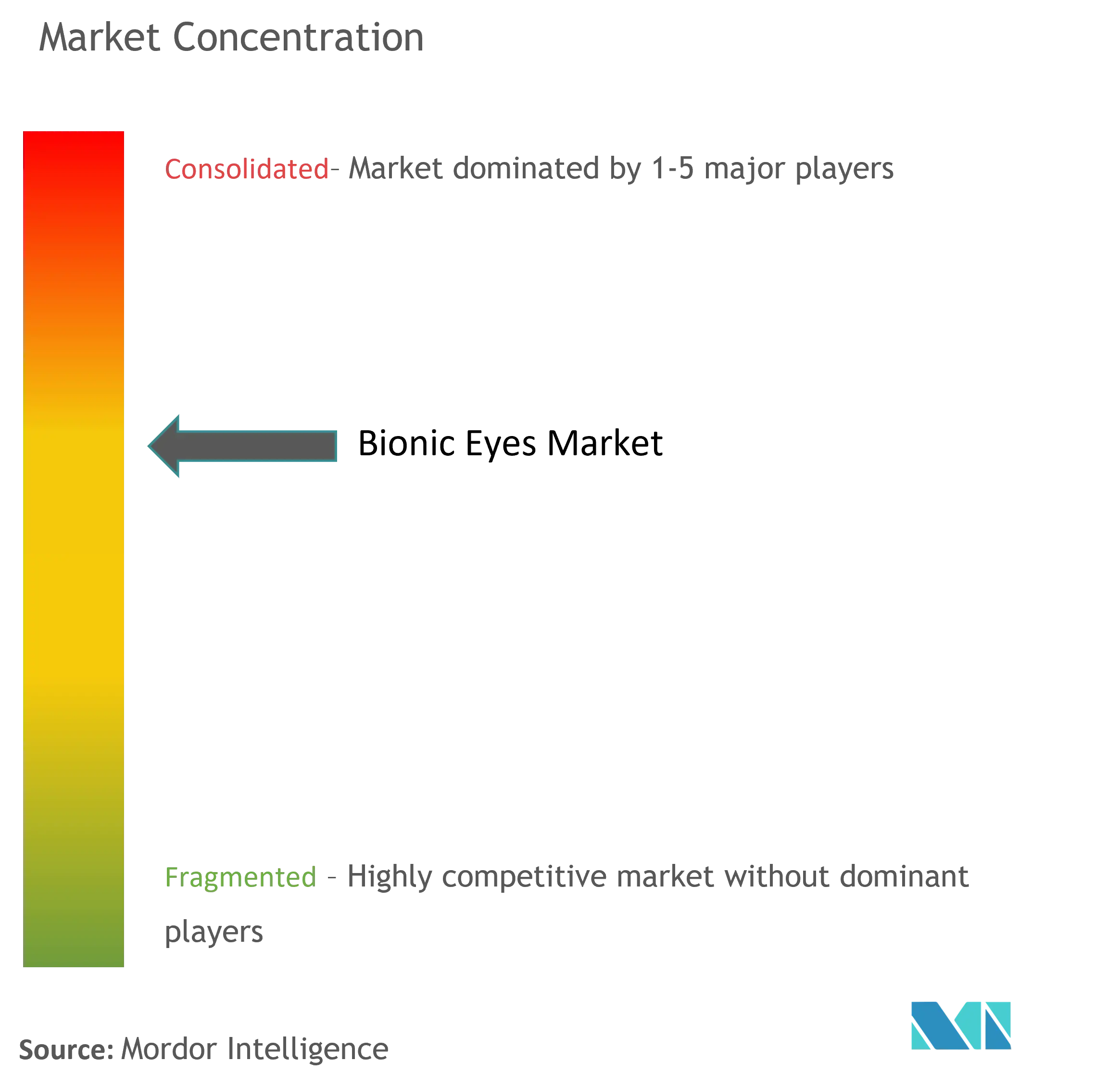
Bionic Eyes Market News
- July 2022: Pixium Vision SA, a bioelectronics company focused on developing bionic vision systems, reported the successful implantation of the first patient in the Netherlands in the PRIMAvera pivotal trial in atrophic dry age-related macular degeneration (dry AMD) following approval of the PRIMAvera study by the Dutch Ministry of Health, Welfare, and Sport and the opening of the first PRIMAvera clinical site in the Netherlands at the Rotterdam Eye Hospital.
- January 2022: The first patient received a bionic eye implant, the Prima System device developed by Pixium Vision in France, for partial vision restoration, creating hope for partial vision restoration for people with geographic atrophy (GA), the most common form of dry AMD.
Table of Contents
1. INTRODUCTION
- 1.1 Study Assumptions and Market Definition
- 1.2 Scope of the Study
2. RESEARCH METHODOLOGY
3. EXECUTIVE SUMMARY
4. MARKET DYNAMICS
- 4.1 Market Overview
-
4.2 Industry Attractiveness - Porter's Five Forces Analysis
- 4.2.1 Bargaining Power of Suppliers
- 4.2.2 Bargaining Power of Consumers
- 4.2.3 Threat of New Entrants
- 4.2.4 Threat of Substitute Products
- 4.2.5 Intensity of Competitive Rivalry
-
4.3 Market Drivers
- 4.3.1 Growing Prevalence of Vision Loss and Other Chronic Eye Diseases
- 4.3.2 Increasing Funding by Private and Public Organizations
- 4.3.3 Rapid Advancements in Technological Developments
-
4.4 Market Restraints
- 4.4.1 High Research and Development Costs
- 4.4.2 Low Awareness Among Target Population Regarding Available Products
5. MARKET SEGMENTATION (Market Size by Value - USD million)
-
5.1 By Type
- 5.1.1 External Eye
- 5.1.2 Implanted Eye
-
5.2 By Technology
- 5.2.1 Mechanical
- 5.2.2 Electronic
-
5.3 By Indication
- 5.3.1 Vision Loss and Impairment
- 5.3.2 Dry Age-related Macular Degeneration (dry AMD)
- 5.3.3 Others
-
5.4 By End User
- 5.4.1 Hospitals
- 5.4.2 Ophthalmic Clinics
- 5.4.3 Others
-
5.5 Geography
- 5.5.1 North America
- 5.5.1.1 United States
- 5.5.1.2 Canada
- 5.5.1.3 Mexico
- 5.5.2 Europe
- 5.5.2.1 United Kingdom
- 5.5.2.2 France
- 5.5.2.3 Germany
- 5.5.2.4 Italy
- 5.5.2.5 Spain
- 5.5.2.6 Rest of Europe
- 5.5.3 Asia-Pacific
- 5.5.3.1 India
- 5.5.3.2 China
- 5.5.3.3 Japan
- 5.5.3.4 Australia
- 5.5.3.5 South Korea
- 5.5.3.6 Rest of Asia-Pacific
- 5.5.4 Middle East and Africa
- 5.5.4.1 GCC
- 5.5.4.2 South Africa
- 5.5.4.3 Rest of Middle East and Africa
- 5.5.5 South America
- 5.5.5.1 Brazil
- 5.5.5.2 Argentina
- 5.5.5.3 Rest of South America
6. OMPETITIVE LANDSCAPE
-
6.1 Company Profiles
- 6.1.1 Vivani Medical Inc.
- 6.1.2 Pixium Vision S.A.
- 6.1.3 Nidek Co., Ltd.
- 6.1.4 Optobionics Corporation
- 6.1.5 Bionic Vision Technologies
- 6.1.6 Monash Vision Group
- 6.1.7 Nano Retina Ltd.
- 6.1.8 iBionics
- *List Not Exhaustive
7. MARKET OPPORTUNITIES AND FUTURE TRENDS
** Subject To AvailablityBionic Eyes Industry Segmentation
As per the scope of the report, retinal prostheses, also known as bionic eye, are retinal implants used as visual prostheses to improve the vision of people with vision loss, vision impairment, and other chronic eye diseases. The Bionic Eye Market is segmented by Type (External Eye and Implanted Eye), Technology (Mechanical and Electronic), Indication (Vision Loss and Impairment, Dry Age-related Macular Degeneration (dry AMD), and Others), End User (Hospitals, Ophthalmic Clinics, and Others (Ambulatory Care Centers), and Geography (North America, Europe, Asia-Pacific, Middle East and Africa, and South America). The market report also covers the estimated market sizes and trends for 17 countries across major regions globally. The report offers the value (in USD million) for the above segments.
| By Type | External Eye | |
| Implanted Eye | ||
| By Technology | Mechanical | |
| Electronic | ||
| By Indication | Vision Loss and Impairment | |
| Dry Age-related Macular Degeneration (dry AMD) | ||
| Others | ||
| By End User | Hospitals | |
| Ophthalmic Clinics | ||
| Others | ||
| Geography | North America | United States |
| Canada | ||
| Mexico | ||
| Geography | Europe | United Kingdom |
| France | ||
| Germany | ||
| Italy | ||
| Spain | ||
| Rest of Europe | ||
| Geography | Asia-Pacific | India |
| China | ||
| Japan | ||
| Australia | ||
| South Korea | ||
| Rest of Asia-Pacific | ||
| Geography | Middle East and Africa | GCC |
| South Africa | ||
| Rest of Middle East and Africa | ||
| Geography | South America | Brazil |
| Argentina | ||
| Rest of South America |
Frequently Asked Questions
What is the current Bionic Eyes Market size?
The Bionic Eyes Market is projected to register a CAGR of 12.97% during the forecast period (2024-2029)
Who are the key players in Bionic Eyes Market?
Pixium Vision S.A., Optobionics Corporation, Bionic Vision Technologies, iBionics and Vivani Medical, Inc. are the major companies operating in the Bionic Eyes Market.
Which is the fastest growing region in Bionic Eyes Market?
Asia Pacific is estimated to grow at the highest CAGR over the forecast period (2024-2029).
Which region has the biggest share in Bionic Eyes Market?
In 2024, the North America accounts for the largest market share in Bionic Eyes Market.
What years does this Bionic Eyes Market cover?
The report covers the Bionic Eyes Market historical market size for years: 2019, 2020, 2021, 2022 and 2023. The report also forecasts the Bionic Eyes Market size for years: 2024, 2025, 2026, 2027, 2028 and 2029.
Bionic Eyes Industry Report
Statistics for the 2024 Bionic Eyes market share, size and revenue growth rate, created by Mordor Intelligence™ Industry Reports. Bionic Eyes analysis includes a market forecast outlook to for 2024 to 2029 and historical overview. Get a sample of this industry analysis as a free report PDF download.



